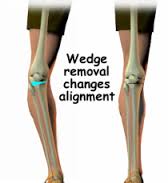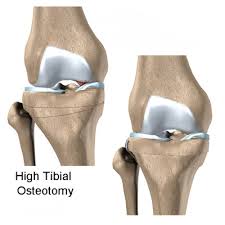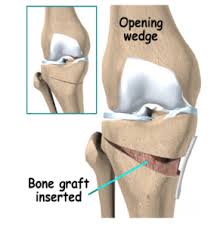Tibial osteotomy is a very useful operation for the younger patient who has osteoarthritis in one side of the knee (typically the inner side or the medial side). It is only for wear and tear osteoarthritis, not for inflammatory arthritis such as rheumatoid arthritis. Osteotomy means cutting bone. Osteotomy involves making a wedge cut in the top of the tibial bone below the knee to change the alignment of the knee, unloading the damaged/worn compartment and using the more normal compartment of the knee to take the load.
Indications:
The idea is that osteoarthritis is due to or can result in mal-alignment of the knee. If the medial side is affected, this can result in varus mal-alignment or bowed knees. By removing a wedge of bone from the top of the tibia the normal alignment can be restored, which unloads the damaged surface from the extra load i.e. a mechanical effect but it also has a biological effect in that the healing has stimulated a blood supply to the arthritic joint as well. Once the correct alignment has been produced, the osteotomy is stabilised with a plate so it will heal in the correct position. Sometimes instead of removing a wedge of bone (a closing wedge osteotomy) an opening wedge from the opposite side can be performed instead.
Tibial osteotomy is ideally indicated for the younger osteoarthritic patient with disease on one side of the joint, who wants to continue an active lifestyle. Knee replacement surgery, no matter how well performed, is not designed for the rigours of a working life, or for a young active sporting lifestyle. Osteotomy can be thought of as an intermediate procedure before total knee replacement is necessary, but it can also be a definitive operation for osteoarthritis as well.
 Expectations:
Expectations:
The patient who has a tibial osteotomy should expect significant relief from pain and disability following surgery. Because the arthritis is not “removed” osteotomy commonly doesn’t provide 100% relief of the patient’s pain. However, a patient will typically be able to safely return to work and physical activity after an osteotomy.
There are many factors which are considered in determining the success of the tibial osteotomy. With the two most important factors to success being the weight of the patient and the angular correction of the surgery. If the two are ideal, then 70% of patients should not require any major surgery for the next 10 years. A successful operation will allow the patient to resume normal activities e.g. heavy manual work. This is the best option in the younger patient who subjects their knee to a lot of stress.
What is involved in the surgery?
Tibial osteotomy is a mechanical solution to osteoarthritis due to mal-alignment. Accurate x-ray and/or CT-scans are used to measure the degree of correction and the size of the wedge that needs to be removed at the time of surgery. Typically a general anaesthetic is used and antibiotics are given intravenously to prevent infection.
A tourniquet is placed around the thigh to stop blood flow and to allow the best visualisation of the operative site. A 15-20cm incision is made on the outside of the knee and the soft tissues are retracted away from the bone, exposing the tibia where the osteotomy will be performed. Usually the joint between the fibula and the tibia is exposed and divided at this point, to avoid pain from here once the osteotomy has been performed.
Retractors are placed carefully around the front and back of the tibia protecting important soft tissues from damage from the instruments (e.g. patellar tendon, major blood vessels and nerves to the leg which are just behind the tibia). X-ray is used to ensure correct placement of the osteotomy. A special jig which dials in the pre-planned degree of correction is positioned correctly using x-ray for guidance. A vibrating power saw is used to cut the wedge of bone out through slots in the jig.
The osteotomy is then slowly closed and compressed and a plate and screws are placed to hold the osteotomy rigidly. A final check with x-ray confirms the position and correction of the osteotomy. The wound is then repaired and the patient is returned to the ward. The surgery typically takes 60-90 minutes.
When an opening wedge osteotomy is chosen a very similar planning process occurs, but instead of a wedge of bone being removed, a singe cut in the bone is made and this is levered opened to the desired correction. A plate is the applied, commonly bone graft from the hip is used to produce early healing of the osteotomy.
The reason for choosing an opening or closing wedge osteotomy will be discussed with you by Dr Lawrie during the planning stage.
Post-operative recovery
The patient usually spends 3-5 days in hospital. The osteotomy usually heals over a period of 3 months. For the last six to eight weeks the knee is typically in a hinged knee brace and all weight is kept off the leg. It is important to realise that the leg will look different following surgery. Apart from a scar, the alignment of the knee will be very different.
Typically it will change from a bowed leg to a knocked knee appearance. A return to manual work typically takes about 3-6 months, though sedentary/office duties can be performed about 2 weeks following surgery. Physiotherapy is usually necessary following surgery to achieve the best outcome following surgery.
Potential Complications
There is a long list of potential complications following osteotomy and this is one of the reasons why some surgeons do not perform the procedure. Osteotomy has potential complications, such as deep venous thrombosis as well as other general complications of any major surgery (heart attack, stroke, chest infection, death etc.).
It also has a risk of local complications such as wound problems, infection, delayed or incomplete bone healing, injury to major nerve and blood vessels, compartment syndrome, irritation from metal work, fracture into the knee joint. Although the list is long, the incidence of complications is quite low. It can be <5% substantially lower than joint replacement surgery and the complications are usually more easily dealt with after osteotomy than knee replacement.
Can I have a knee replacement after osteotomy and will it be as good?
Yes. Studies show that knee replacement surgery after osteotomy is as successful as a routine primary knee replacement. However, it is technically more difficult for the surgeon. Importantly this may not be the case if a uni-compartmental knee replacement is done first.
Should I have a uni-compartmental knee replacement rather than an osteotomy?
The uni-compartmental knee replacement (UKA) is an excellent operation for the right patient. It should not be thought of as an alternative to osteotomy. UKA is designed for the low demand sedentary patient with antero-medial arthritis, as a definitive procedure. If it fails and knee replacement surgery is necessary, the results are similar to revision knee replacement surgery, not primary knee replacement surgery.
Osteotomy is designed for the high demand patient and it has a good fall back in total knee replacement; this is not the case for UKA
Download

